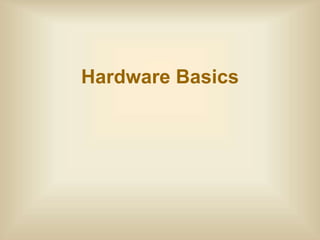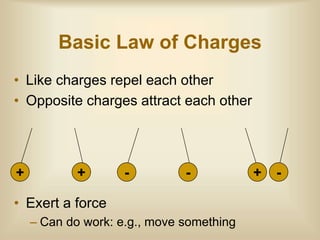hardware.ppt
- 2. Electricity • Electricity is the flow of electrons • Atoms contain – In the nucleus (center) • Protons with a positive charge • Neutrons with no charge (no consequence here) – “Orbiting” around the nucleus • Electrons with a negative charge - + + + + - - -
- 3. Charged Atoms • Atoms with more protons that electrons – Positively charged – Try to acquire additional electrons to get back in balance • Atoms with more electrons than protons – Negatively charged – Want to give up electrons to get back in balance • If you set up an imbalance, electrons will try to jump (flow) between atoms to correct this – This flow is electricity
- 4. Conductors and Insulators • Materials that allow electrons to flow easily are conductors – Most metals are good conductors • Materials that don’t allow electrons to flow easily are insulators – E.g., plastic, rubber, glass • Some materials can be influenced to change from conducting to insulating (a very useful property) Semiconductors
- 5. Basic Law of Charges • Like charges repel each other • Opposite charges attract each other • Exert a force – Can do work: e.g., move something + - + + - -
- 6. Charge • Charge is measured in Coulombs ( C ) – (A unit we won’t use much) – Measure of how many more protons than electrons in a substance – 1 Coulomb = 2.15 x 1018 excess protons 2.15 x 1018 extra electrons = -1 C
- 7. Electromotive Force (Voltage) • Charge has the ability to do work – A “potential” to e.g. move something in one direction or another • Difference in potential (in charge) provides a force: Electromotive Force (EMF): Voltage Extra electron s EMF (voltage) +
- 8. Flow of electrons • If this is a conductor then ½ the excess electrons will very rapidly flow to the other end to balance the charge Conductor Extra electron s EMF (voltage) +
- 9. Flow of electrons • If this is a conductor then ½ the excess electrons will very rapidly flow to the other end to balance the charge Conductor 0 voltage ½ the extra electrons
- 10. Flow of electrons • If this is a conductor then ½ the excess electrons will very rapidly flow to the other end to balance the charge • And then things are not very interesting Conductor 0 voltage ½ the extra electrons
- 11. Flow of electrons • If this is a conductor then ½ the excess electrons will very rapidly flow to the other end to balance the charge • And then things are not very interesting – Hence we set up circuits (cycles, loops) to keep this going
- 12. Flow of Electrons • “Current” is the flow of electrons • Measured in Amperes (Amp, or A) – 1A is 1 Coulomb of charge flowing past a point per second
- 13. Current vs. Voltage • Water analogy – Useful, but only goes so far • Coulombs analogous to quantity (gallons) • Amps analogous to flow rate (gallons / sec) • Voltage analogous to pressure (lbs/ft2)
- 14. Resistance • Can have a lot of flow at low pressure or a lot of pressure but low volume – Depends on the size of the pipe • Resistance is analogous to the size of the pipe • Resistance is the opposition to current flow • Measured in Ohms ( Ω )
- 15. Ohm’s Law • Relates current, voltage, and resistance • Current normally denoted by variable I • Voltage normally denoted by variable V • Resistance normally denoted by variable R V = I * R
- 16. Ohm’s Law • V = IR • R = V / I • I = V / R V I R
- 17. Ohm’s Law • In the electronics we will do, we tend to (try to) hold the voltage constant (or zero) – Typically 5v • starting to use 3.3v, but 5v still most common • I = V / R I = 5 / R – Raise the resistance, current drops – Lower the resistance, current rises
- 18. Ohm’s Law • I = V / R I = 5 / R – Raise the resistance, current drops – Lower the resistance, current rises • What happens if we lower the resistance towards zeros?
- 19. Ohm’s Law • I = V / R I = 5 / R – Raise the resistance, current drops – Lower the resistance, current rises • What happens if we lower the resistance towards zeros? – Current goes towards infinity – Power = V * I (related to heat) • Boom! (or Poof!)
- 20. Current Limiting • Important – This is how you (literally) fry hardware if you don’t pay attention (trust me, I know) • Always think carefully (and check!) that the path from 5v source – From power supply, or from output pin of a chip to ground (0v location) has appropriate resistance – Not a “short circuit” ~0Ω – Current limiting resistor at value needed to stay within current limits of the device
- 21. Aside: Units • Volts, Amps, Ohms • Normally use metric system unit prefixes mega M million 1,000,000 106 kilo k thousand 1,000 103 one 1 100 milli m thousandth 0.001 10-3 micro μ millionth 0.000 001 10-6 nano n billionth 10-9 pico p trillionth 10-12
- 22. Examples 5V with 10Ω  5/10 A = 0.5A = 500mA • For typical chips you will use = Poof! 5V with 100Ω  5/100 A = 50mA • Still Poof! 5V with 250Ω  5/250 A = 20mA • OK for PIC processors, not for lots of other digital electronics 5V with 10kΩ  5/10000 A = 0.5mA • Good for most digital electronics
- 23. Schematic Diagrams xx • Wire, connection, cross, hop-over • Resistor, variable resistor (pot, rheostat) • Battery, switch • Capacitor, electrolytic capacitor • Diode, LED • Transistor (PNP, NPN) • Inductor, transformer • Integrated circuit
- 25. AC vs. DC • DC – Direct Current – Current flows steadily in one direction – Most of what we will do is DC • AC – Alternating Current – Current flows in one direction then another – Wall current does this • Alternating 60 times per sec • 60 Hz V V
- 26. Capacitance • Capacitor – Device with two conducting plates separated by insulating material (called dielectric) – Stores electric charge in the dielectric – Water metaphor • Consider a pipe with a rubber balloon blocking it • DC current bulges out the balloon (charges the capacitor) – But then stops flowing – Release the pressure the charge drains back out over time • AC current can go back and forth continuously Capacitor blocks DC but allows AC to pass
- 27. Capacitance • Capacitance is measured in Farads ( F ) and denoted by variable C – Amount of charge divided by voltage across plates • Charge (in Coulombs) denoted by Q • C = Q / V
- 28. Series and Parallel Circuits • Series circuit • Parallel circuit
- 29. Series and Parallel Circuits • Combining resistors • Rtotal-series = R1 + R2 • Rtotal-par = (R1 * R2) / (R1 + R2) R1 R2 R1 R2
- 30. Series and Parallel Circuits Combining capacitors • Ctotal-series = (C1 * C2) / (C1 + C2) • Ctotal-par = C1 + C2 C1 C2 C1 C2
- 31. Digital Electronics • Computer circuits treat signals as digital values – Consider signals to only have two states: 1 or 0 – +5v is considered to be “1” – 0v is considered to be “0”
- 32. Digital Electronics • But need to leave some room for error or fluctuation – Between VHMin and +5v considered 1 – Between 0v and VLmax considered 0 – Between VLmax and VHMin is undefined (and unpredictable) • Can pass through this but you don’t want to stay there long +5v 0v VHMin VLmax 1 0 ??
































